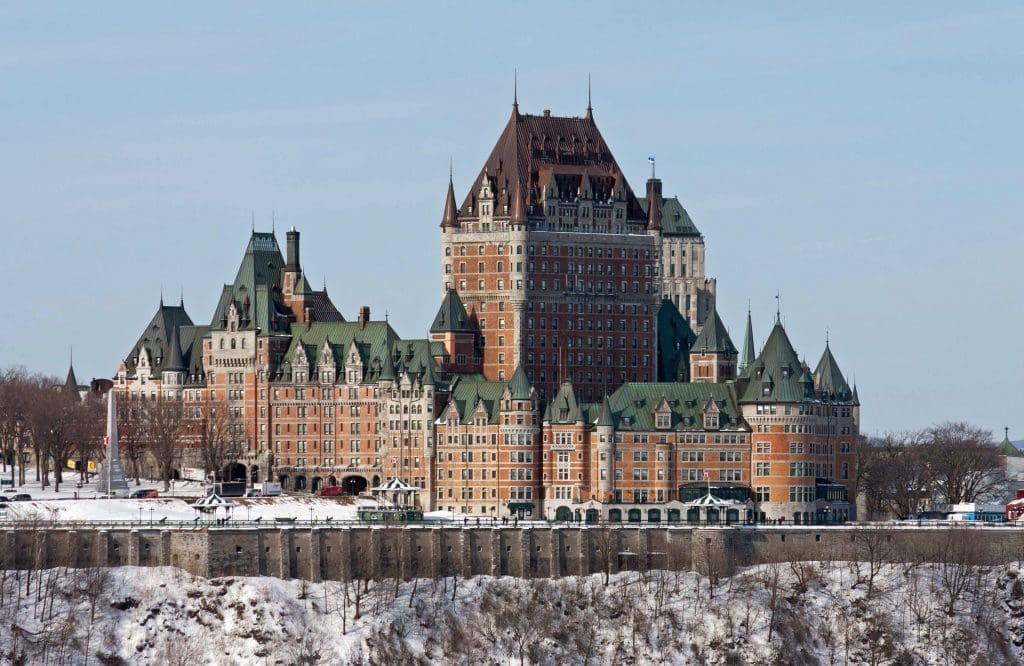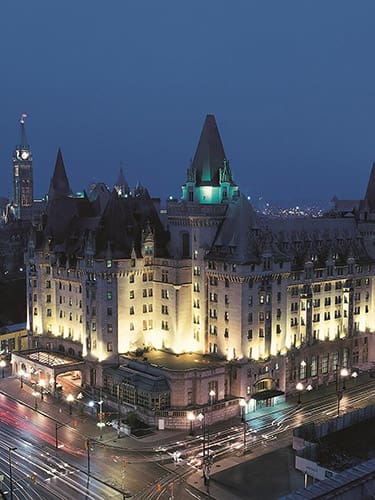
Canadian chateaux style: design movement or good marketing?
We Canadians like to think that one of our distinguishing qualities is humility, or our lack of ‘flash’. However, an ostentatiousness little movement made its way into our world. Fairmont hotels and old Imperial banks are a familiar scene nestled into city, town, and country scapes. Their look is somewhat known as the railway hotel style. The Canadian Pacific Railway seemed to want to represent the height of Canadian opulence. Every decorative object associated with C. P. Rail, from stemware to car paneling to light fixtures, boasted monarchic grandeur. The TransCanada train line was even once known as “the Millionaire’s Express,” comparable to today’s private jet circuit.
The architectural aesthetic is called ‘Canadian chateau style’. Canadian chateau style experienced intermittent revivals since its beginning, about 130 years ago. Was this unusual design movement more of a reach for a national style or more of a marketing ploy? How, how much, and what exactly did we ‘borrow’ from our imperials?

First Phase: Scottish barons
Perhaps the answer is not so simple. The beginning of ‘Chateau style’ was more than a natural amalgamation of baronial conquerors’ tastes. The trend had financial motives. The owners of the Chateau Frontenac Hotel (Quebec City, 1892-93), an early chateau project, had a board majority of CPR members who wanted to establish broad commercial success. They did this by copying sophisticated trends from the nation’s imperialists (France and Britain). Several chateau structures, including the Glacier House in Glacier, were erected in the 1880s in BC with the intent of attracting tourists. It worked. In 1886, the C.P.R. hired major New York architect Bruce Price Price, who is generally credited with bringing a refined chateau style to Canada. Amateur Canadian architect William Van Horne (1842-1915) also contributed to early chateau design. In 1902, the federal Minister of Public works professed the climactic appropriateness of the style over its cultural relevance. Percy Nobbs, the president of the Royal Architectural Institute of Canada and Professor of Design at McGill University, later proclaimed that ‘Canadian chateau style’ had become synonymous with ‘railway hotel style’. This means that the design style did not really ‘trickle down’ to the domestic realm. Rather, it instead stayed in a clearly defined context.

Chateau style is often associated with French and English design, but its original intention was to copy medieval Scottish baronial castles. Nobbs was one of a many Scottish born and trained architects who shaped chateau style in Canada. British influence was even behind patronage. The London stock exchange was most of the money behind Canadian property development until 1919. Between the 1860s and early 1900s, the many Scottish men in political power in Canada made sure that Baronial-chateau style became ‘the’ railway hotel and bank look. Scottish Baronial style, which honored French Second Empire design, was a popular hotel trend in mid-late 19th century in England. British architect David Bryce (1803-1876) brought characteristic features of chateau style to Canada such as bartizans (protruding castle tower) and other types of towers, crow-stepped gables (triangular, stepped façade), chamfering (a type of beveled edge), steep roofs, and French chateaux dormer and oriel styles. Bryce continued to develop the style, which was no longer popular in Scotland, in order to attract a wealthy middle-class clientele in Canada.
Second phase: Francophilia and the American industrial socialites
Canadians and Americans have a history of art, design, and culinary students studying with French experts abroad. The flux of French-education in the late 1800s resulted in a boom of French Second Empire style hotels in Canada and US. Famous examples of this boom include W. W. Boyington’s Windsor Hotel in Montreal, H. J. Hardenbergh’s Waldorf Astoria and Plaza Hotels in New York City, and Rattenbury’s Empress Hotel in Victoria. Van Horne and Hayes, canonical Canadian architects, were heavily influenced by architects to the American industrial socialites such as R. M. Hunt (who designed, for example, the Vanderbilt’s Biltmore mansion). The late Victorian (late 1800s) phase of chateau style (e.g., Chateau Rideau in Kingston, Ontario) had acquired Scottish, English, American, and French visual vocabulary.

Third phase: Coming into our own?

By the time the late phase of Chateau style came about in Canada, the style had declined in Britain and the United States. In the early 1900s, as other major Canadian design movements have done, Canada was developing an increasingly sophisticated, consistent, and distinct style. Chateau Frontenac’s new wing, Ottawa’s government buildings, and Chateau Laurier were all commissioned around 1908. The design team Ross and MacFarlane copied the style of American architect B. L. Gilbert and as a result won the design competition for the Laurier. In 1911, the duo produced chateau designs for hotels including Grand Trunk Pacific Railway’s hotels in Winnipeg and Edmonton. Other architects such as Rattenbury, Painter, Orrock, Barott, Blackader, W. S. Maxwell, and Price also continued to attract wealthy Canadians by recalling the grandeur of Scottish castles. Post war, design language became more and more eclectic and incorporated ideas from ornate Louis XIV to modern classical to the ancients. The Empress Hotel (first opened in 1908) is considered one of the first and best examples of mature Chateau style. Like the Laurier, the Empress features flat, unornamented surfaces, does not suggest size or scale, has steep broken roofs, detailed upper parts, gothic style dormers, and an emphasis on vertical lines. The late Chateau structures re-recalled French chateaus in a characteristically muted way. Railway style hotels during this period were extremely popular and profitable, and numerous hotels required multiple expansions.
Further revival
By the 1930s, chateau style was considered ‘unrecognized’ as a Canadian style by the Royal Architectural Institute of Canada. New chateau superstructures such as the CPR Royal York Hotel in Toronto offered a confused pastiche of appropriated motifs and rooflines that tried to prolong the Baronial-chateau aesthetic. The federal government, however, continued to support and recognize the style and commissioned government buildings such as the Confederation Building (Ottawa), the Seaforth Highlanders of Canada Armoury (Vancouver), the Supreme Court of Canada (Ottawa), and the Lord Elgin Hotel (Ottawa). The string of federal commissions after World War II embodied a revival of chateau style.
The 1980s saw the erection of several said style structures such as the Whistler Hotel (near Vancouver) and Cathedral Place (Vancouver).

“Canadian chateau style is a lot of things. Its style phases are a result of a combination of commercial efforts, politics, the strive for a national style, serious design study, cultural colonialism, and colonialism. Whatever it is, the movement is a unique and curious marvel of Canadian social history and architectural scenery.” – Eileen Kosasih

Additional info: chateau (ontarioarchitecture.com)
sources
Kalman, Harold D. “The Railway Hotels and the Development of the Chateau Style in Canada,” University of Victoria Maltwood Museum: Studies in Architectural History Number One, The Morriss Printing Company, 1968
Liscombe, Rhadri Windsor. “Nationalism or Cultural Imperialism?: The Chateau Style in Canada,” Architectural History, 1993, Vol. 36, pp. 127-144.